BET 405: Traffic Signal Design and Analysis Report
VerifiedAdded on 2022/10/01
|14
|2384
|311
Report
AI Summary
This report delves into the intricacies of traffic signal design, focusing on the application of traffic engineering principles to optimize traffic flow and enhance road safety at the intersection of Dalton Road and Childs Road. The study begins with an abstract that highlights the significance of effective traffic signals in mitigating road accidents and managing traffic congestion. The introduction provides a historical overview of traffic signal development, emphasizing the evolution of these systems in response to increasing traffic demands and technological advancements. The report then outlines the elements of a good traffic signal, including the importance of data-driven engineering studies, adherence to design standards, and regular maintenance. Data analysis includes vehicle counts, and the application of the Poisson distribution model to understand traffic arrival patterns. The report proceeds with a discussion on the design of a traffic control signal, considering factors such as intersection infrastructure, road user behavior, and the use of detectors to adjust signal timing. Finally, the report proposes a signal phasing plan that allocates green light time based on traffic volume, aiming to minimize delays and optimize traffic flow, with a focus on the specific conditions at the intersection under consideration.
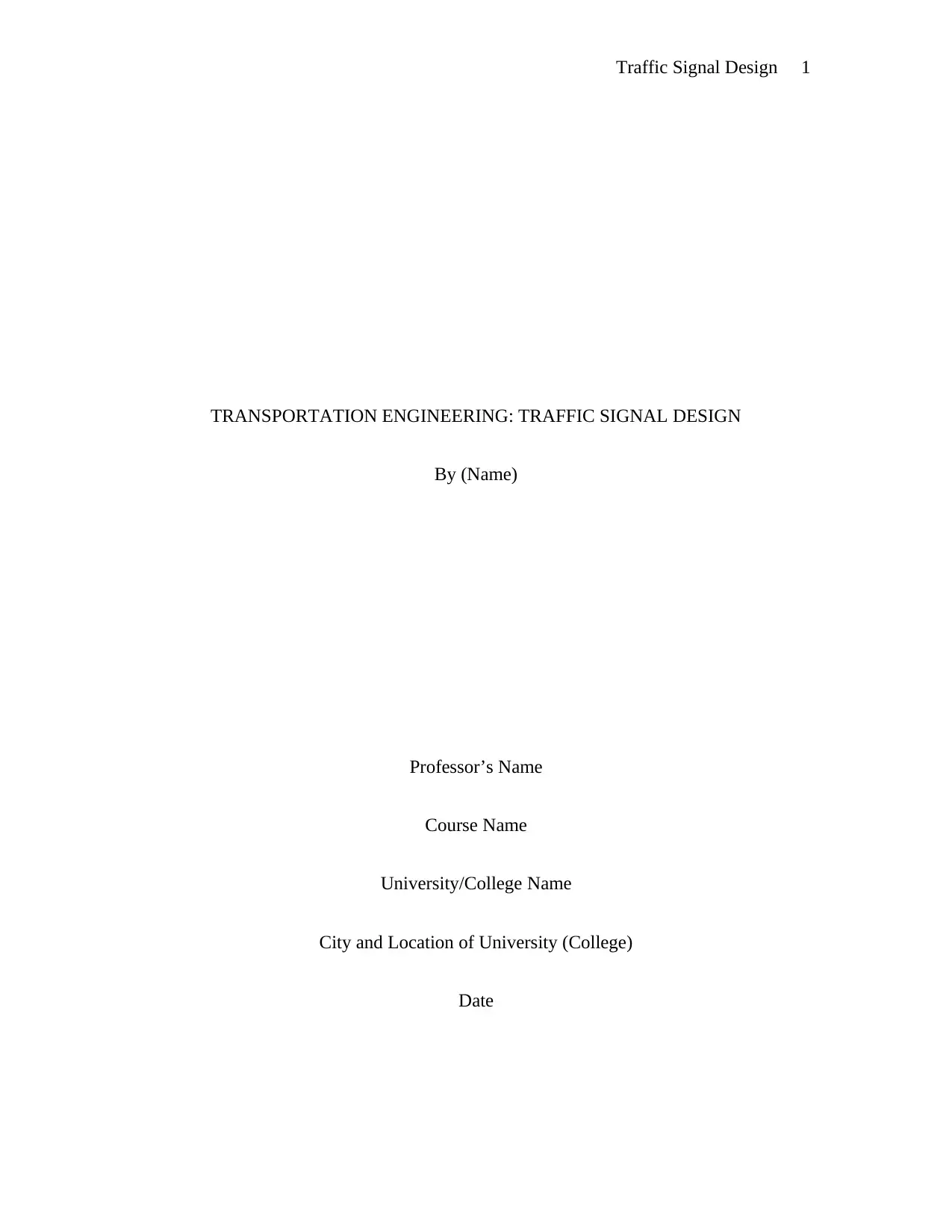
Traffic Signal Design 1
TRANSPORTATION ENGINEERING: TRAFFIC SIGNAL DESIGN
By (Name)
Professor’s Name
Course Name
University/College Name
City and Location of University (College)
Date
TRANSPORTATION ENGINEERING: TRAFFIC SIGNAL DESIGN
By (Name)
Professor’s Name
Course Name
University/College Name
City and Location of University (College)
Date
Paraphrase This Document
Need a fresh take? Get an instant paraphrase of this document with our AI Paraphraser

Traffic Signal Design 2
Abstract
This paper explores the topic of traffic signal design for the purpose of mitigating road accidents
and limiting road use chaos. The paper explores the process of designing an effective traffic
signal that will effectively cater to the traffic demands of a given road intersection by managing
the delay time and volume of vehicles flowing from the connecting roads. The elements of a
good traffic signal are evaluated to ensure that a feasible and effective design is developed. One
of the key findings indicates that a good intersection traffic signal has to be able to control
vehicle movement in an equitable manner that takes into consideration the influx of vehicles
from different direction. Another pivotal finding specifies that a good traffic signal is durable
and function regardless of the weather (foggy, rainy, or snowy). In conclusion, we are able to see
that an effective traffic signal for a busy intersection has to take into account the volume of
vehicles coming from different direction in order to effectively assign right of way without
causing vehicle congestion.
Abstract
This paper explores the topic of traffic signal design for the purpose of mitigating road accidents
and limiting road use chaos. The paper explores the process of designing an effective traffic
signal that will effectively cater to the traffic demands of a given road intersection by managing
the delay time and volume of vehicles flowing from the connecting roads. The elements of a
good traffic signal are evaluated to ensure that a feasible and effective design is developed. One
of the key findings indicates that a good intersection traffic signal has to be able to control
vehicle movement in an equitable manner that takes into consideration the influx of vehicles
from different direction. Another pivotal finding specifies that a good traffic signal is durable
and function regardless of the weather (foggy, rainy, or snowy). In conclusion, we are able to see
that an effective traffic signal for a busy intersection has to take into account the volume of
vehicles coming from different direction in order to effectively assign right of way without
causing vehicle congestion.
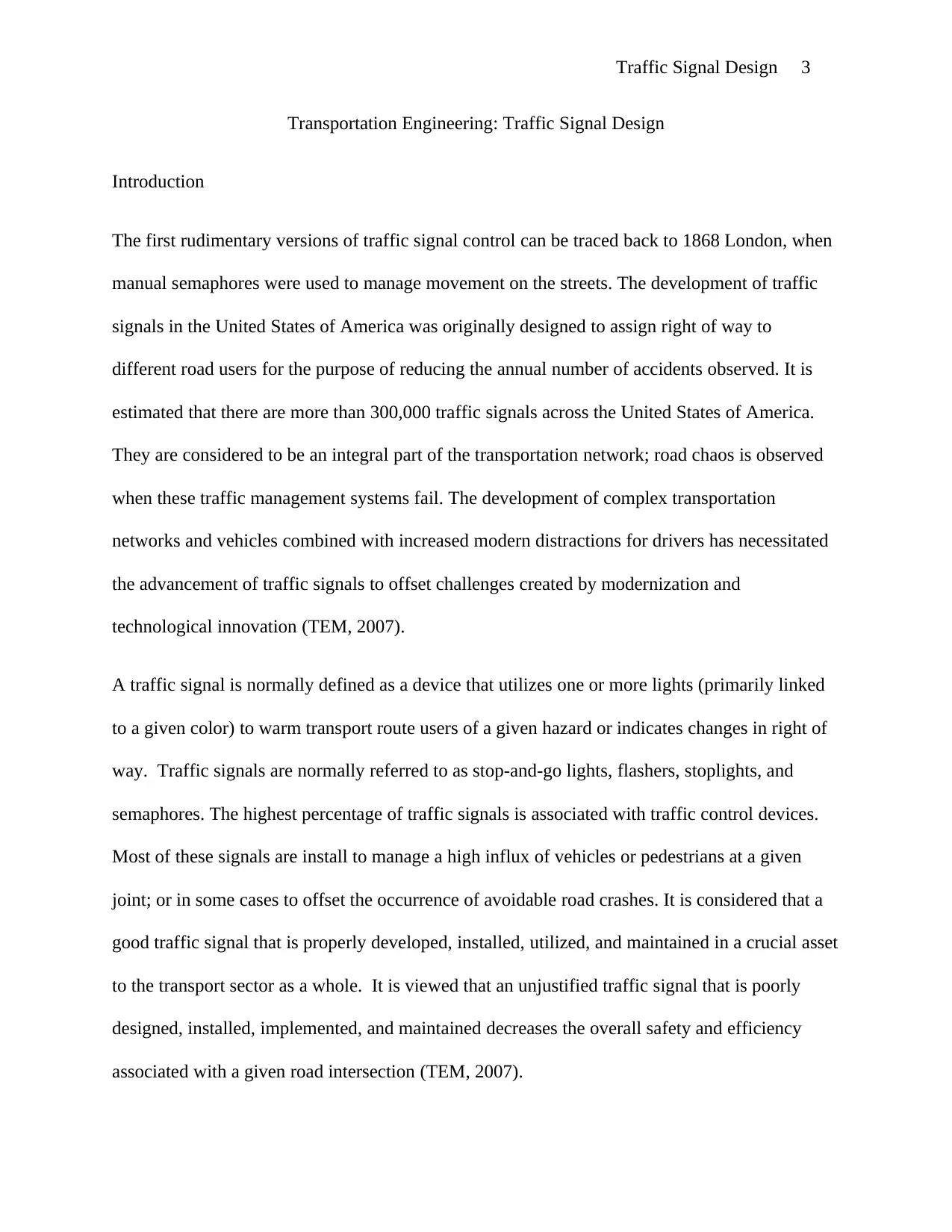
Traffic Signal Design 3
Transportation Engineering: Traffic Signal Design
Introduction
The first rudimentary versions of traffic signal control can be traced back to 1868 London, when
manual semaphores were used to manage movement on the streets. The development of traffic
signals in the United States of America was originally designed to assign right of way to
different road users for the purpose of reducing the annual number of accidents observed. It is
estimated that there are more than 300,000 traffic signals across the United States of America.
They are considered to be an integral part of the transportation network; road chaos is observed
when these traffic management systems fail. The development of complex transportation
networks and vehicles combined with increased modern distractions for drivers has necessitated
the advancement of traffic signals to offset challenges created by modernization and
technological innovation (TEM, 2007).
A traffic signal is normally defined as a device that utilizes one or more lights (primarily linked
to a given color) to warm transport route users of a given hazard or indicates changes in right of
way. Traffic signals are normally referred to as stop-and-go lights, flashers, stoplights, and
semaphores. The highest percentage of traffic signals is associated with traffic control devices.
Most of these signals are install to manage a high influx of vehicles or pedestrians at a given
joint; or in some cases to offset the occurrence of avoidable road crashes. It is considered that a
good traffic signal that is properly developed, installed, utilized, and maintained in a crucial asset
to the transport sector as a whole. It is viewed that an unjustified traffic signal that is poorly
designed, installed, implemented, and maintained decreases the overall safety and efficiency
associated with a given road intersection (TEM, 2007).
Transportation Engineering: Traffic Signal Design
Introduction
The first rudimentary versions of traffic signal control can be traced back to 1868 London, when
manual semaphores were used to manage movement on the streets. The development of traffic
signals in the United States of America was originally designed to assign right of way to
different road users for the purpose of reducing the annual number of accidents observed. It is
estimated that there are more than 300,000 traffic signals across the United States of America.
They are considered to be an integral part of the transportation network; road chaos is observed
when these traffic management systems fail. The development of complex transportation
networks and vehicles combined with increased modern distractions for drivers has necessitated
the advancement of traffic signals to offset challenges created by modernization and
technological innovation (TEM, 2007).
A traffic signal is normally defined as a device that utilizes one or more lights (primarily linked
to a given color) to warm transport route users of a given hazard or indicates changes in right of
way. Traffic signals are normally referred to as stop-and-go lights, flashers, stoplights, and
semaphores. The highest percentage of traffic signals is associated with traffic control devices.
Most of these signals are install to manage a high influx of vehicles or pedestrians at a given
joint; or in some cases to offset the occurrence of avoidable road crashes. It is considered that a
good traffic signal that is properly developed, installed, utilized, and maintained in a crucial asset
to the transport sector as a whole. It is viewed that an unjustified traffic signal that is poorly
designed, installed, implemented, and maintained decreases the overall safety and efficiency
associated with a given road intersection (TEM, 2007).
⊘ This is a preview!⊘
Do you want full access?
Subscribe today to unlock all pages.

Trusted by 1+ million students worldwide
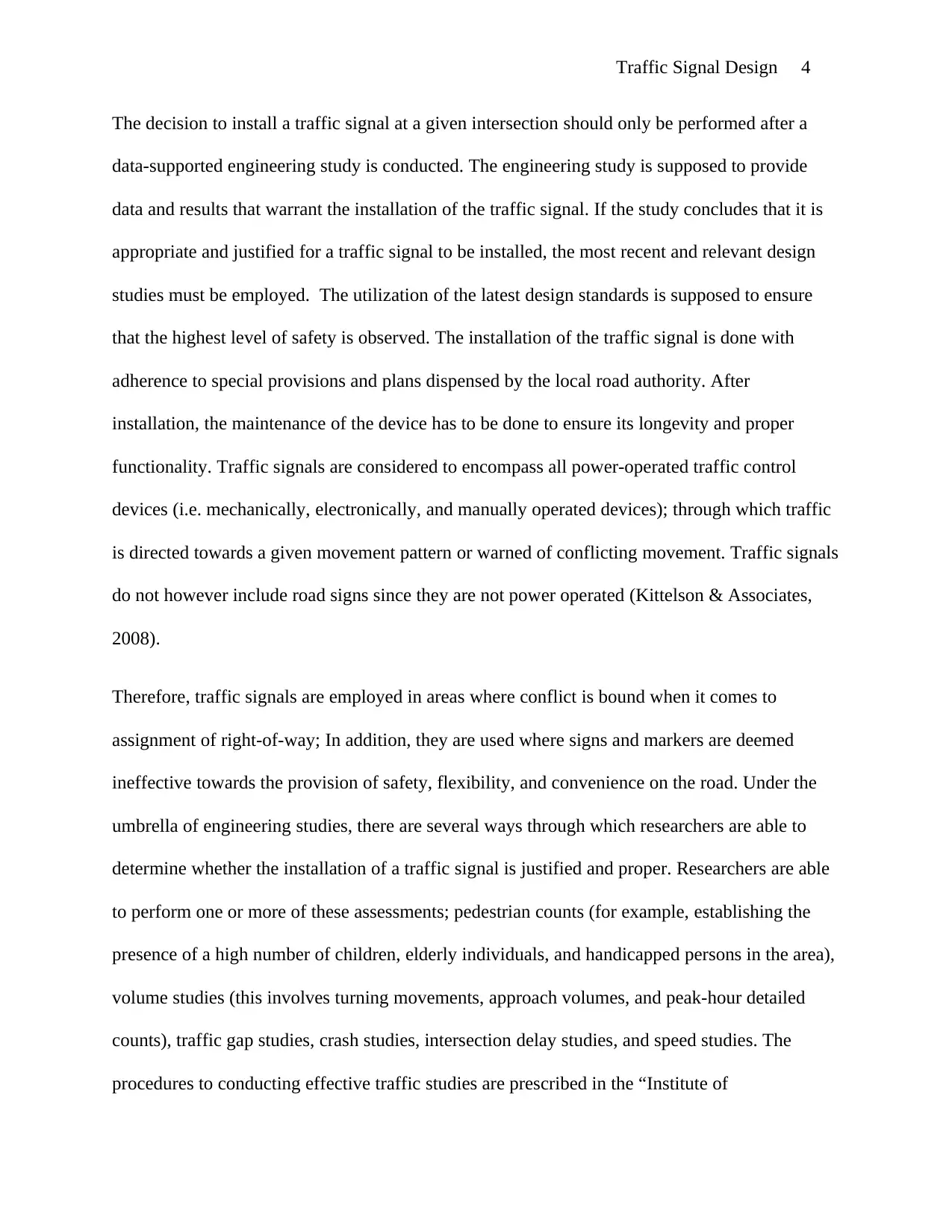
Traffic Signal Design 4
The decision to install a traffic signal at a given intersection should only be performed after a
data-supported engineering study is conducted. The engineering study is supposed to provide
data and results that warrant the installation of the traffic signal. If the study concludes that it is
appropriate and justified for a traffic signal to be installed, the most recent and relevant design
studies must be employed. The utilization of the latest design standards is supposed to ensure
that the highest level of safety is observed. The installation of the traffic signal is done with
adherence to special provisions and plans dispensed by the local road authority. After
installation, the maintenance of the device has to be done to ensure its longevity and proper
functionality. Traffic signals are considered to encompass all power-operated traffic control
devices (i.e. mechanically, electronically, and manually operated devices); through which traffic
is directed towards a given movement pattern or warned of conflicting movement. Traffic signals
do not however include road signs since they are not power operated (Kittelson & Associates,
2008).
Therefore, traffic signals are employed in areas where conflict is bound when it comes to
assignment of right-of-way; In addition, they are used where signs and markers are deemed
ineffective towards the provision of safety, flexibility, and convenience on the road. Under the
umbrella of engineering studies, there are several ways through which researchers are able to
determine whether the installation of a traffic signal is justified and proper. Researchers are able
to perform one or more of these assessments; pedestrian counts (for example, establishing the
presence of a high number of children, elderly individuals, and handicapped persons in the area),
volume studies (this involves turning movements, approach volumes, and peak-hour detailed
counts), traffic gap studies, crash studies, intersection delay studies, and speed studies. The
procedures to conducting effective traffic studies are prescribed in the “Institute of
The decision to install a traffic signal at a given intersection should only be performed after a
data-supported engineering study is conducted. The engineering study is supposed to provide
data and results that warrant the installation of the traffic signal. If the study concludes that it is
appropriate and justified for a traffic signal to be installed, the most recent and relevant design
studies must be employed. The utilization of the latest design standards is supposed to ensure
that the highest level of safety is observed. The installation of the traffic signal is done with
adherence to special provisions and plans dispensed by the local road authority. After
installation, the maintenance of the device has to be done to ensure its longevity and proper
functionality. Traffic signals are considered to encompass all power-operated traffic control
devices (i.e. mechanically, electronically, and manually operated devices); through which traffic
is directed towards a given movement pattern or warned of conflicting movement. Traffic signals
do not however include road signs since they are not power operated (Kittelson & Associates,
2008).
Therefore, traffic signals are employed in areas where conflict is bound when it comes to
assignment of right-of-way; In addition, they are used where signs and markers are deemed
ineffective towards the provision of safety, flexibility, and convenience on the road. Under the
umbrella of engineering studies, there are several ways through which researchers are able to
determine whether the installation of a traffic signal is justified and proper. Researchers are able
to perform one or more of these assessments; pedestrian counts (for example, establishing the
presence of a high number of children, elderly individuals, and handicapped persons in the area),
volume studies (this involves turning movements, approach volumes, and peak-hour detailed
counts), traffic gap studies, crash studies, intersection delay studies, and speed studies. The
procedures to conducting effective traffic studies are prescribed in the “Institute of
Paraphrase This Document
Need a fresh take? Get an instant paraphrase of this document with our AI Paraphraser
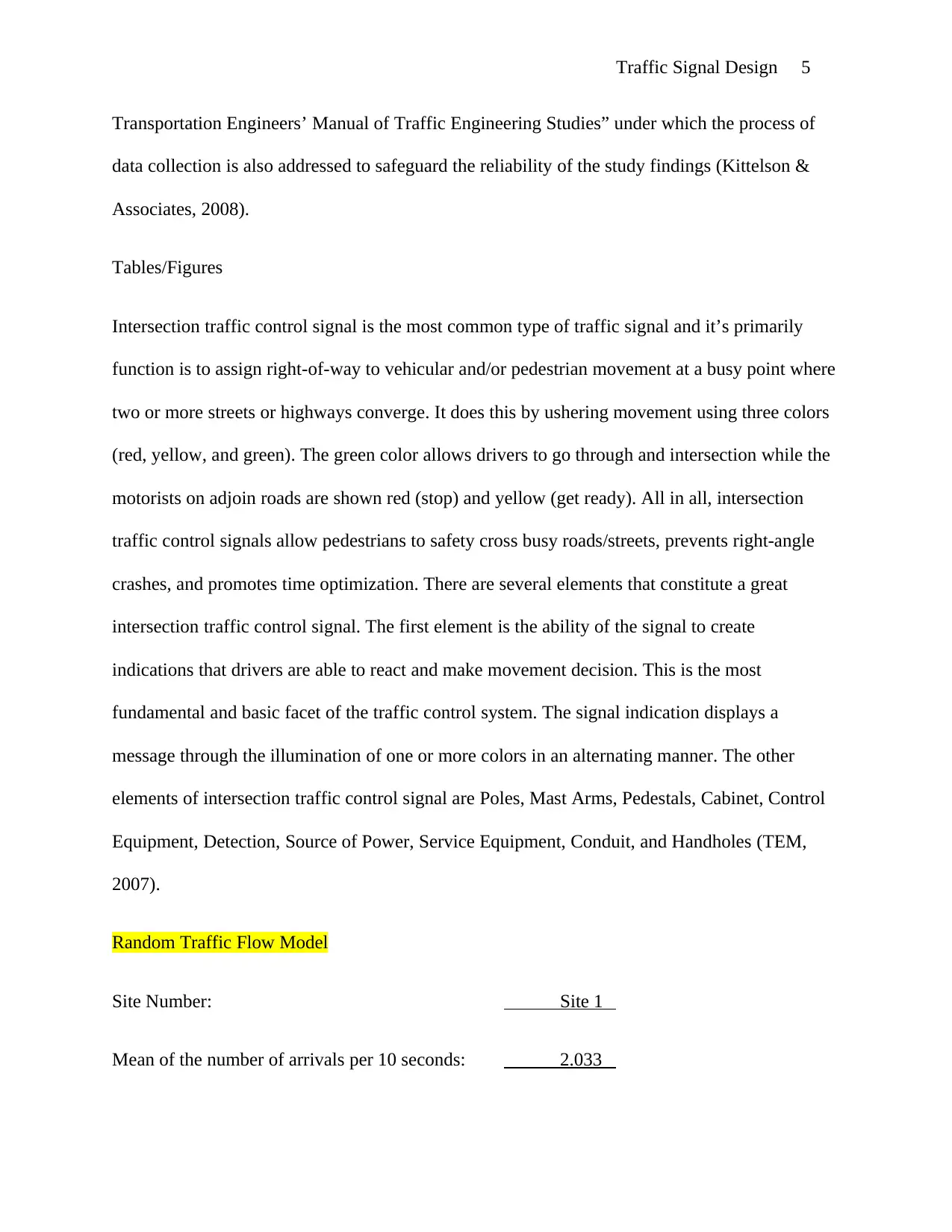
Traffic Signal Design 5
Transportation Engineers’ Manual of Traffic Engineering Studies” under which the process of
data collection is also addressed to safeguard the reliability of the study findings (Kittelson &
Associates, 2008).
Tables/Figures
Intersection traffic control signal is the most common type of traffic signal and it’s primarily
function is to assign right-of-way to vehicular and/or pedestrian movement at a busy point where
two or more streets or highways converge. It does this by ushering movement using three colors
(red, yellow, and green). The green color allows drivers to go through and intersection while the
motorists on adjoin roads are shown red (stop) and yellow (get ready). All in all, intersection
traffic control signals allow pedestrians to safety cross busy roads/streets, prevents right-angle
crashes, and promotes time optimization. There are several elements that constitute a great
intersection traffic control signal. The first element is the ability of the signal to create
indications that drivers are able to react and make movement decision. This is the most
fundamental and basic facet of the traffic control system. The signal indication displays a
message through the illumination of one or more colors in an alternating manner. The other
elements of intersection traffic control signal are Poles, Mast Arms, Pedestals, Cabinet, Control
Equipment, Detection, Source of Power, Service Equipment, Conduit, and Handholes (TEM,
2007).
Random Traffic Flow Model
Site Number: Site 1
Mean of the number of arrivals per 10 seconds: 2.033
Transportation Engineers’ Manual of Traffic Engineering Studies” under which the process of
data collection is also addressed to safeguard the reliability of the study findings (Kittelson &
Associates, 2008).
Tables/Figures
Intersection traffic control signal is the most common type of traffic signal and it’s primarily
function is to assign right-of-way to vehicular and/or pedestrian movement at a busy point where
two or more streets or highways converge. It does this by ushering movement using three colors
(red, yellow, and green). The green color allows drivers to go through and intersection while the
motorists on adjoin roads are shown red (stop) and yellow (get ready). All in all, intersection
traffic control signals allow pedestrians to safety cross busy roads/streets, prevents right-angle
crashes, and promotes time optimization. There are several elements that constitute a great
intersection traffic control signal. The first element is the ability of the signal to create
indications that drivers are able to react and make movement decision. This is the most
fundamental and basic facet of the traffic control system. The signal indication displays a
message through the illumination of one or more colors in an alternating manner. The other
elements of intersection traffic control signal are Poles, Mast Arms, Pedestals, Cabinet, Control
Equipment, Detection, Source of Power, Service Equipment, Conduit, and Handholes (TEM,
2007).
Random Traffic Flow Model
Site Number: Site 1
Mean of the number of arrivals per 10 seconds: 2.033
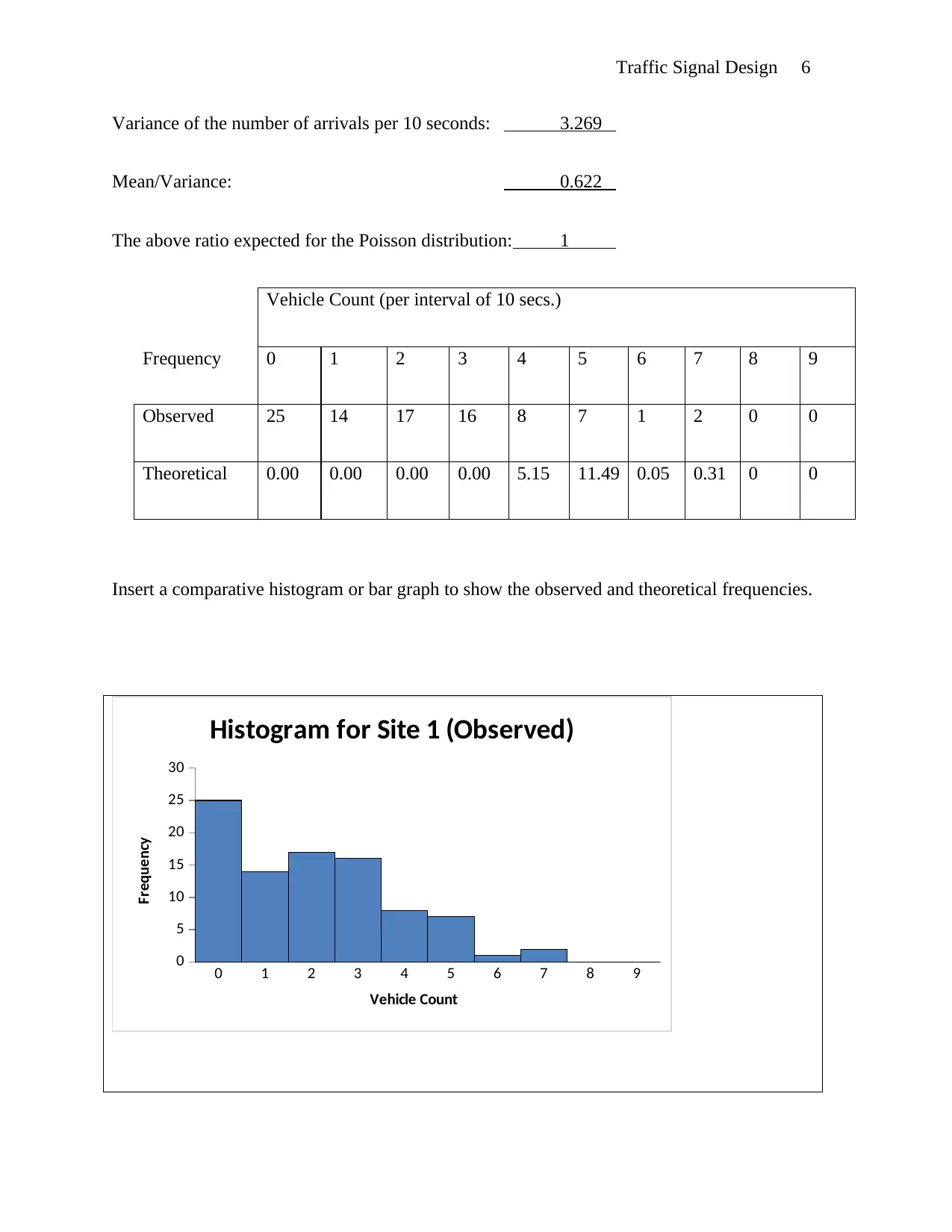
Traffic Signal Design 6
Variance of the number of arrivals per 10 seconds: 3.269
Mean/Variance: 0.622
The above ratio expected for the Poisson distribution: 1
Vehicle Count (per interval of 10 secs.)
Frequency 0 1 2 3 4 5 6 7 8 9
Observed 25 14 17 16 8 7 1 2 0 0
Theoretical 0.00 0.00 0.00 0.00 5.15 11.49 0.05 0.31 0 0
Insert a comparative histogram or bar graph to show the observed and theoretical frequencies.
0 1 2 3 4 5 6 7 8 9
0
5
10
15
20
25
30
Histogram for Site 1 (Observed)
Vehicle Count
Frequency
Variance of the number of arrivals per 10 seconds: 3.269
Mean/Variance: 0.622
The above ratio expected for the Poisson distribution: 1
Vehicle Count (per interval of 10 secs.)
Frequency 0 1 2 3 4 5 6 7 8 9
Observed 25 14 17 16 8 7 1 2 0 0
Theoretical 0.00 0.00 0.00 0.00 5.15 11.49 0.05 0.31 0 0
Insert a comparative histogram or bar graph to show the observed and theoretical frequencies.
0 1 2 3 4 5 6 7 8 9
0
5
10
15
20
25
30
Histogram for Site 1 (Observed)
Vehicle Count
Frequency
⊘ This is a preview!⊘
Do you want full access?
Subscribe today to unlock all pages.

Trusted by 1+ million students worldwide
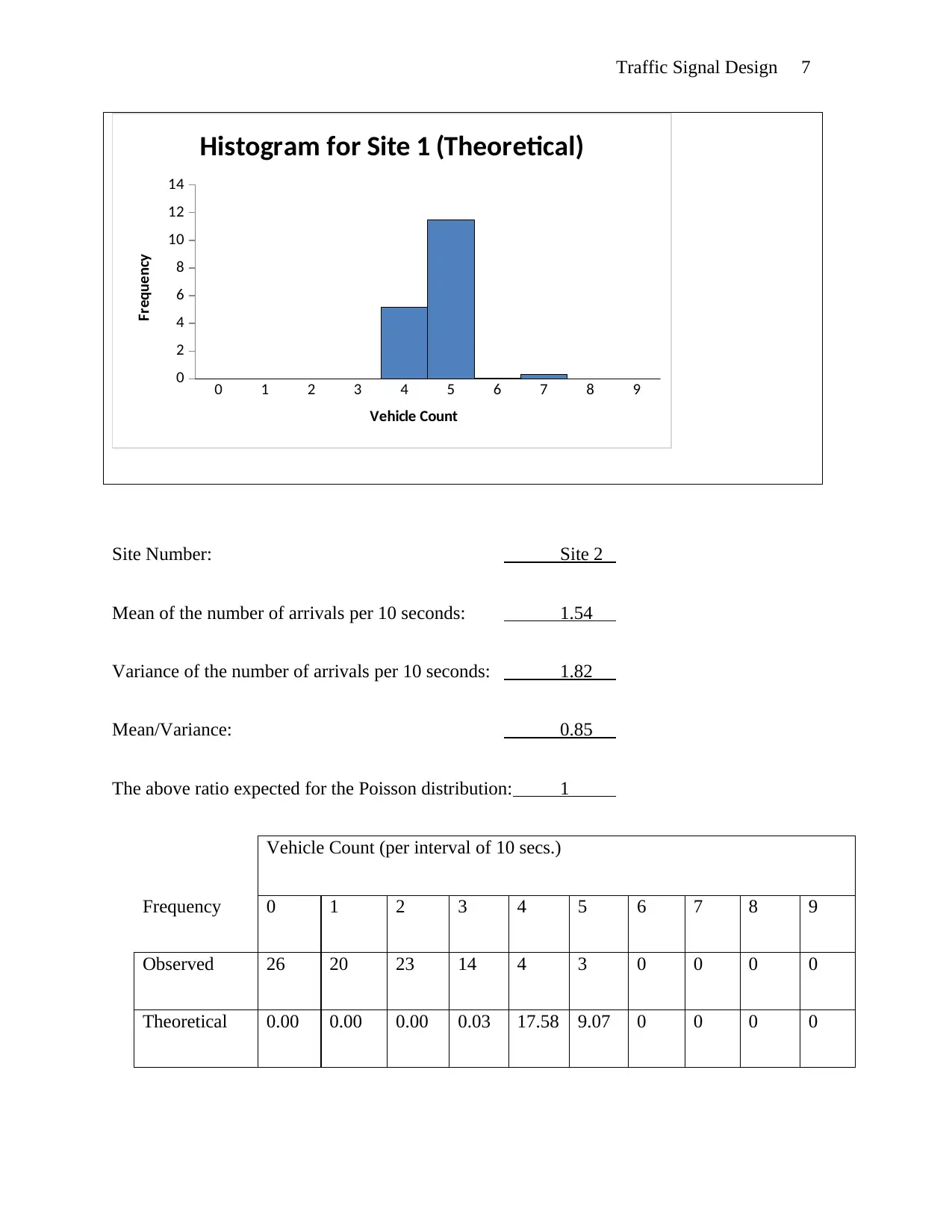
Traffic Signal Design 7
0 1 2 3 4 5 6 7 8 9
0
2
4
6
8
10
12
14
Histogram for Site 1 (Theoretical)
Vehicle Count
Frequency
Site Number: Site 2
Mean of the number of arrivals per 10 seconds: 1.54
Variance of the number of arrivals per 10 seconds: 1.82
Mean/Variance: 0.85
The above ratio expected for the Poisson distribution: 1
Vehicle Count (per interval of 10 secs.)
Frequency 0 1 2 3 4 5 6 7 8 9
Observed 26 20 23 14 4 3 0 0 0 0
Theoretical 0.00 0.00 0.00 0.03 17.58 9.07 0 0 0 0
0 1 2 3 4 5 6 7 8 9
0
2
4
6
8
10
12
14
Histogram for Site 1 (Theoretical)
Vehicle Count
Frequency
Site Number: Site 2
Mean of the number of arrivals per 10 seconds: 1.54
Variance of the number of arrivals per 10 seconds: 1.82
Mean/Variance: 0.85
The above ratio expected for the Poisson distribution: 1
Vehicle Count (per interval of 10 secs.)
Frequency 0 1 2 3 4 5 6 7 8 9
Observed 26 20 23 14 4 3 0 0 0 0
Theoretical 0.00 0.00 0.00 0.03 17.58 9.07 0 0 0 0
Paraphrase This Document
Need a fresh take? Get an instant paraphrase of this document with our AI Paraphraser
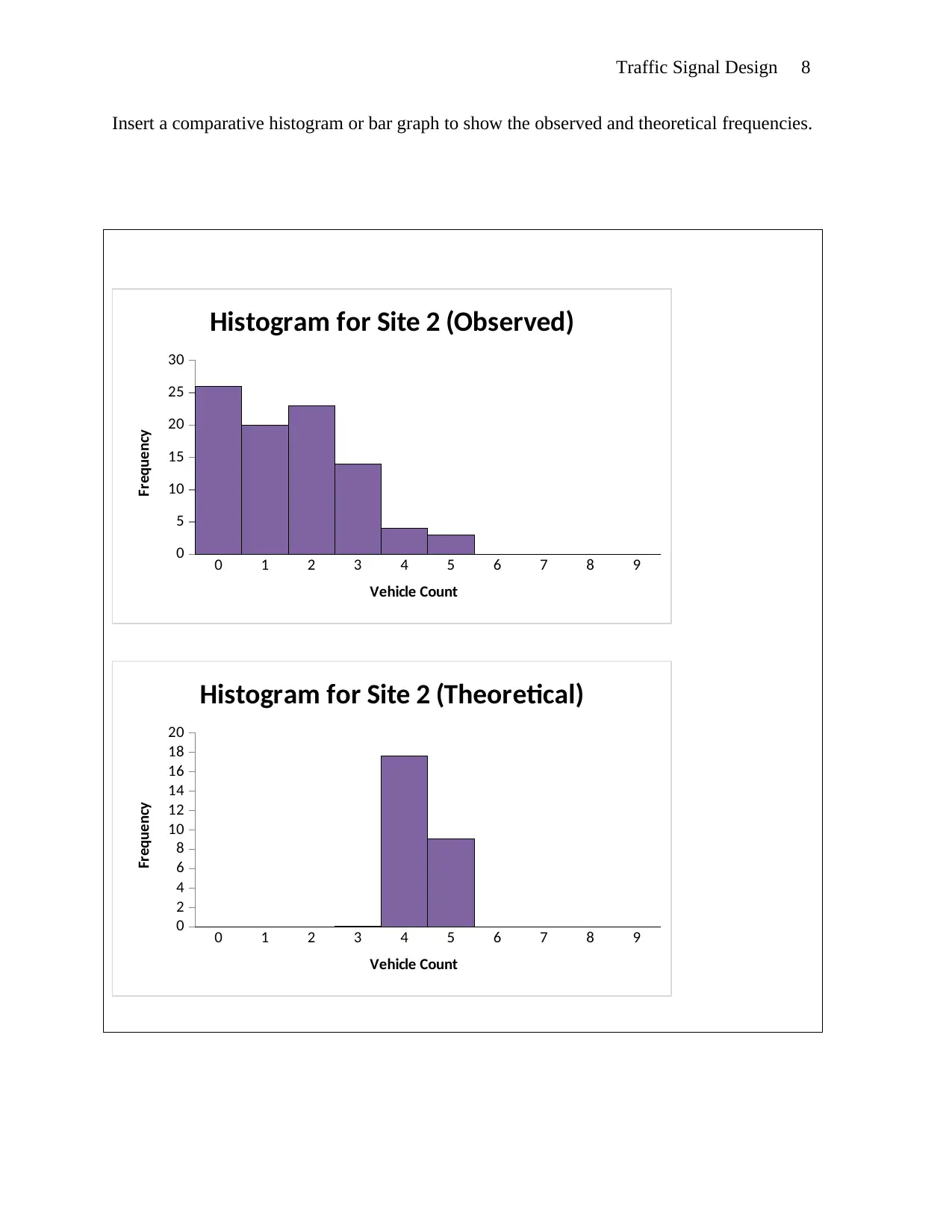
Traffic Signal Design 8
Insert a comparative histogram or bar graph to show the observed and theoretical frequencies.
0 1 2 3 4 5 6 7 8 9
0
5
10
15
20
25
30
Histogram for Site 2 (Observed)
Vehicle Count
Frequency
0 1 2 3 4 5 6 7 8 9
0
2
4
6
8
10
12
14
16
18
20
Histogram for Site 2 (Theoretical)
Vehicle Count
Frequency
Insert a comparative histogram or bar graph to show the observed and theoretical frequencies.
0 1 2 3 4 5 6 7 8 9
0
5
10
15
20
25
30
Histogram for Site 2 (Observed)
Vehicle Count
Frequency
0 1 2 3 4 5 6 7 8 9
0
2
4
6
8
10
12
14
16
18
20
Histogram for Site 2 (Theoretical)
Vehicle Count
Frequency
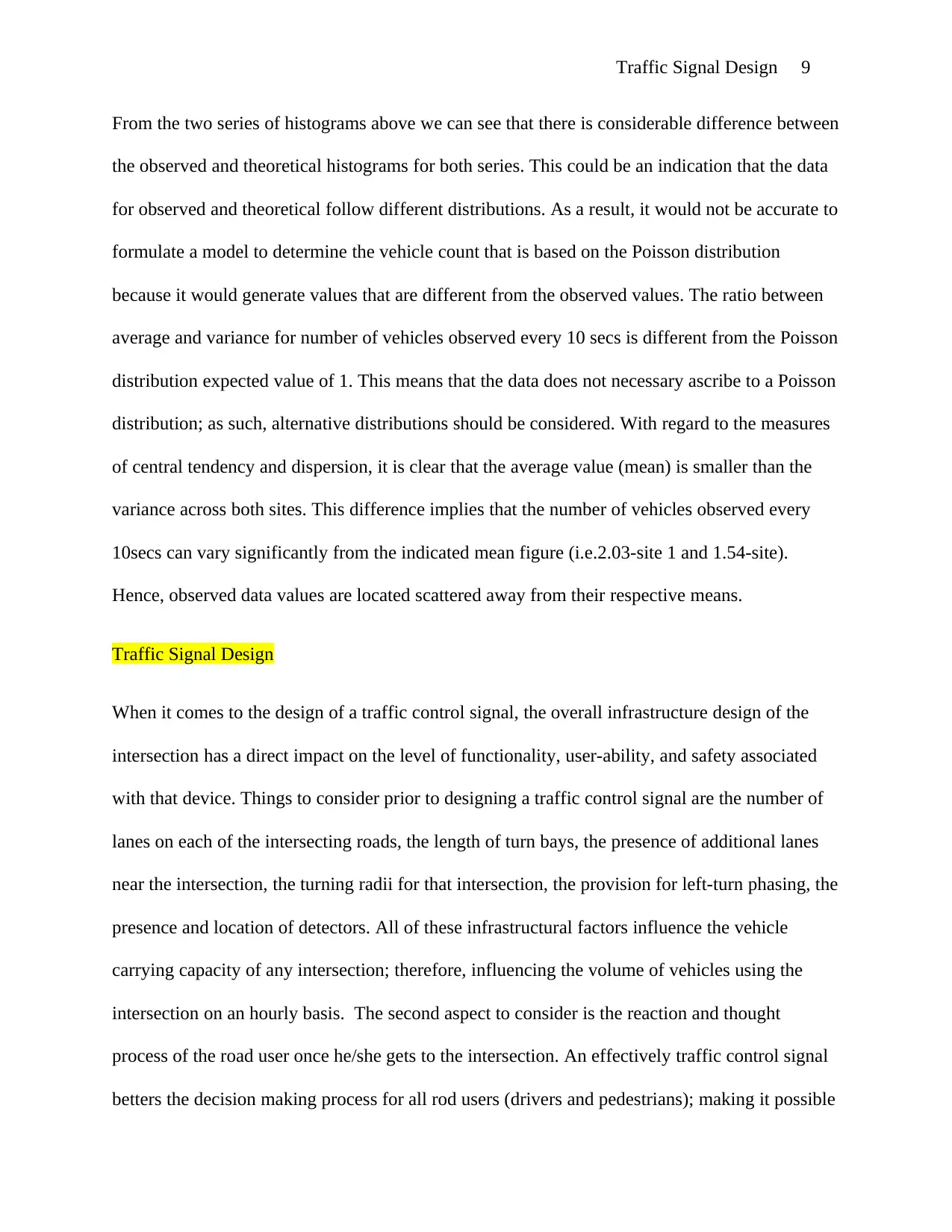
Traffic Signal Design 9
From the two series of histograms above we can see that there is considerable difference between
the observed and theoretical histograms for both series. This could be an indication that the data
for observed and theoretical follow different distributions. As a result, it would not be accurate to
formulate a model to determine the vehicle count that is based on the Poisson distribution
because it would generate values that are different from the observed values. The ratio between
average and variance for number of vehicles observed every 10 secs is different from the Poisson
distribution expected value of 1. This means that the data does not necessary ascribe to a Poisson
distribution; as such, alternative distributions should be considered. With regard to the measures
of central tendency and dispersion, it is clear that the average value (mean) is smaller than the
variance across both sites. This difference implies that the number of vehicles observed every
10secs can vary significantly from the indicated mean figure (i.e.2.03-site 1 and 1.54-site).
Hence, observed data values are located scattered away from their respective means.
Traffic Signal Design
When it comes to the design of a traffic control signal, the overall infrastructure design of the
intersection has a direct impact on the level of functionality, user-ability, and safety associated
with that device. Things to consider prior to designing a traffic control signal are the number of
lanes on each of the intersecting roads, the length of turn bays, the presence of additional lanes
near the intersection, the turning radii for that intersection, the provision for left-turn phasing, the
presence and location of detectors. All of these infrastructural factors influence the vehicle
carrying capacity of any intersection; therefore, influencing the volume of vehicles using the
intersection on an hourly basis. The second aspect to consider is the reaction and thought
process of the road user once he/she gets to the intersection. An effectively traffic control signal
betters the decision making process for all rod users (drivers and pedestrians); making it possible
From the two series of histograms above we can see that there is considerable difference between
the observed and theoretical histograms for both series. This could be an indication that the data
for observed and theoretical follow different distributions. As a result, it would not be accurate to
formulate a model to determine the vehicle count that is based on the Poisson distribution
because it would generate values that are different from the observed values. The ratio between
average and variance for number of vehicles observed every 10 secs is different from the Poisson
distribution expected value of 1. This means that the data does not necessary ascribe to a Poisson
distribution; as such, alternative distributions should be considered. With regard to the measures
of central tendency and dispersion, it is clear that the average value (mean) is smaller than the
variance across both sites. This difference implies that the number of vehicles observed every
10secs can vary significantly from the indicated mean figure (i.e.2.03-site 1 and 1.54-site).
Hence, observed data values are located scattered away from their respective means.
Traffic Signal Design
When it comes to the design of a traffic control signal, the overall infrastructure design of the
intersection has a direct impact on the level of functionality, user-ability, and safety associated
with that device. Things to consider prior to designing a traffic control signal are the number of
lanes on each of the intersecting roads, the length of turn bays, the presence of additional lanes
near the intersection, the turning radii for that intersection, the provision for left-turn phasing, the
presence and location of detectors. All of these infrastructural factors influence the vehicle
carrying capacity of any intersection; therefore, influencing the volume of vehicles using the
intersection on an hourly basis. The second aspect to consider is the reaction and thought
process of the road user once he/she gets to the intersection. An effectively traffic control signal
betters the decision making process for all rod users (drivers and pedestrians); making it possible
⊘ This is a preview!⊘
Do you want full access?
Subscribe today to unlock all pages.

Trusted by 1+ million students worldwide
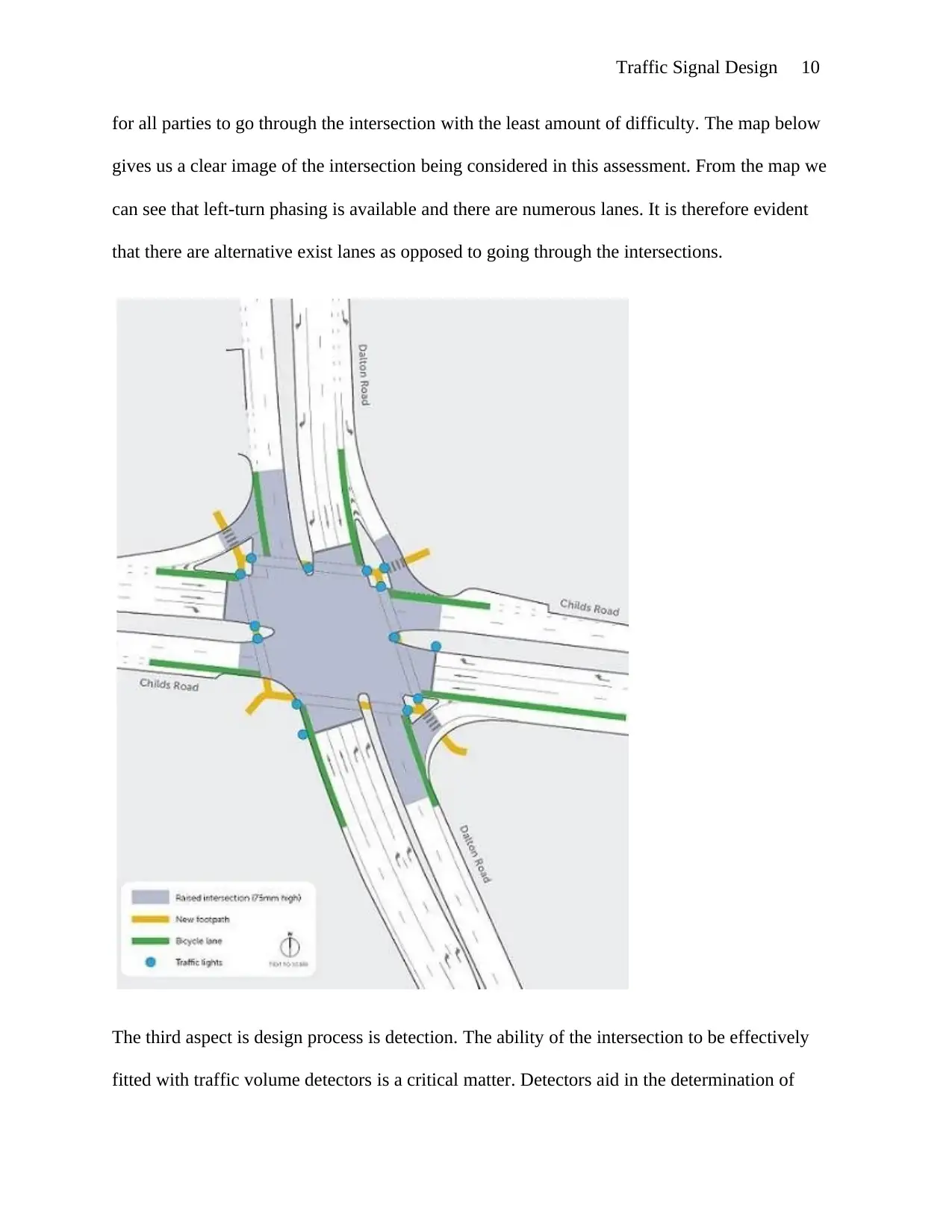
Traffic Signal Design 10
for all parties to go through the intersection with the least amount of difficulty. The map below
gives us a clear image of the intersection being considered in this assessment. From the map we
can see that left-turn phasing is available and there are numerous lanes. It is therefore evident
that there are alternative exist lanes as opposed to going through the intersections.
The third aspect is design process is detection. The ability of the intersection to be effectively
fitted with traffic volume detectors is a critical matter. Detectors aid in the determination of
for all parties to go through the intersection with the least amount of difficulty. The map below
gives us a clear image of the intersection being considered in this assessment. From the map we
can see that left-turn phasing is available and there are numerous lanes. It is therefore evident
that there are alternative exist lanes as opposed to going through the intersections.
The third aspect is design process is detection. The ability of the intersection to be effectively
fitted with traffic volume detectors is a critical matter. Detectors aid in the determination of
Paraphrase This Document
Need a fresh take? Get an instant paraphrase of this document with our AI Paraphraser

Traffic Signal Design 11
driver and pedestrian needs at a given intersection thereby making adjustments to traffic control
signals in a way that is more flexible compared to pre-timed control. Detectors allow for changes
to be made when it comes to the assignment of right-of-way; as a response to abnormal levels of
traffic coming from one direction or a traffic accident near the intersection. A properly
functioning detector maintains continuous communication with the controller to ensure that the
traffic control signal at the intersection is working smoothly. The image below is an illustration
of an automatic detector that can be installed along side all the traffic control signals placed at
the intersection of Childs Road and Dalton Road.
The critical movement around the
intersection indicates that any
vehicle entering the around about
has three exit options; Therefore,
there needs to be a traffic control
signal for each of the four enters/exits at the intersection. The lights are supposed to switch from
one leg of the roundabout to the next. The signal phase will change every 2 minutes to ensures
that a significant number of cars move from one side to the next. The signal phases are red,
yellow, and green. The three signal phases will change with regard to the Webster’s approach
that optimizes the signal cycle time in a manner that minimizes the delay time to vehicles
approaching the intersection.
driver and pedestrian needs at a given intersection thereby making adjustments to traffic control
signals in a way that is more flexible compared to pre-timed control. Detectors allow for changes
to be made when it comes to the assignment of right-of-way; as a response to abnormal levels of
traffic coming from one direction or a traffic accident near the intersection. A properly
functioning detector maintains continuous communication with the controller to ensure that the
traffic control signal at the intersection is working smoothly. The image below is an illustration
of an automatic detector that can be installed along side all the traffic control signals placed at
the intersection of Childs Road and Dalton Road.
The critical movement around the
intersection indicates that any
vehicle entering the around about
has three exit options; Therefore,
there needs to be a traffic control
signal for each of the four enters/exits at the intersection. The lights are supposed to switch from
one leg of the roundabout to the next. The signal phase will change every 2 minutes to ensures
that a significant number of cars move from one side to the next. The signal phases are red,
yellow, and green. The three signal phases will change with regard to the Webster’s approach
that optimizes the signal cycle time in a manner that minimizes the delay time to vehicles
approaching the intersection.
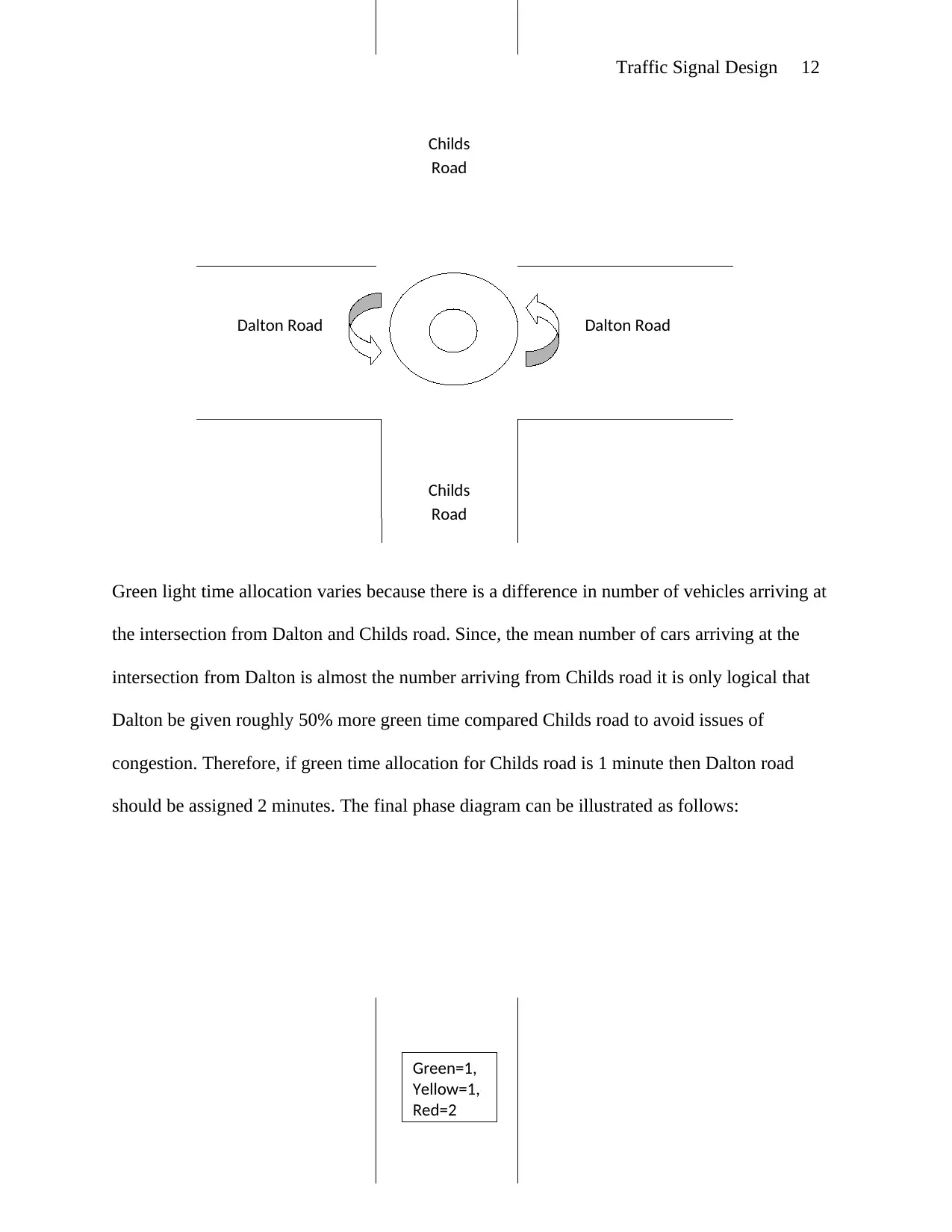
Traffic Signal Design 12
Green light time allocation varies because there is a difference in number of vehicles arriving at
the intersection from Dalton and Childs road. Since, the mean number of cars arriving at the
intersection from Dalton is almost the number arriving from Childs road it is only logical that
Dalton be given roughly 50% more green time compared Childs road to avoid issues of
congestion. Therefore, if green time allocation for Childs road is 1 minute then Dalton road
should be assigned 2 minutes. The final phase diagram can be illustrated as follows:
Dalton Road Dalton Road
Childs
Road
Childs
Road
Green=1,
Yellow=1,
Red=2
Green light time allocation varies because there is a difference in number of vehicles arriving at
the intersection from Dalton and Childs road. Since, the mean number of cars arriving at the
intersection from Dalton is almost the number arriving from Childs road it is only logical that
Dalton be given roughly 50% more green time compared Childs road to avoid issues of
congestion. Therefore, if green time allocation for Childs road is 1 minute then Dalton road
should be assigned 2 minutes. The final phase diagram can be illustrated as follows:
Dalton Road Dalton Road
Childs
Road
Childs
Road
Green=1,
Yellow=1,
Red=2
⊘ This is a preview!⊘
Do you want full access?
Subscribe today to unlock all pages.

Trusted by 1+ million students worldwide
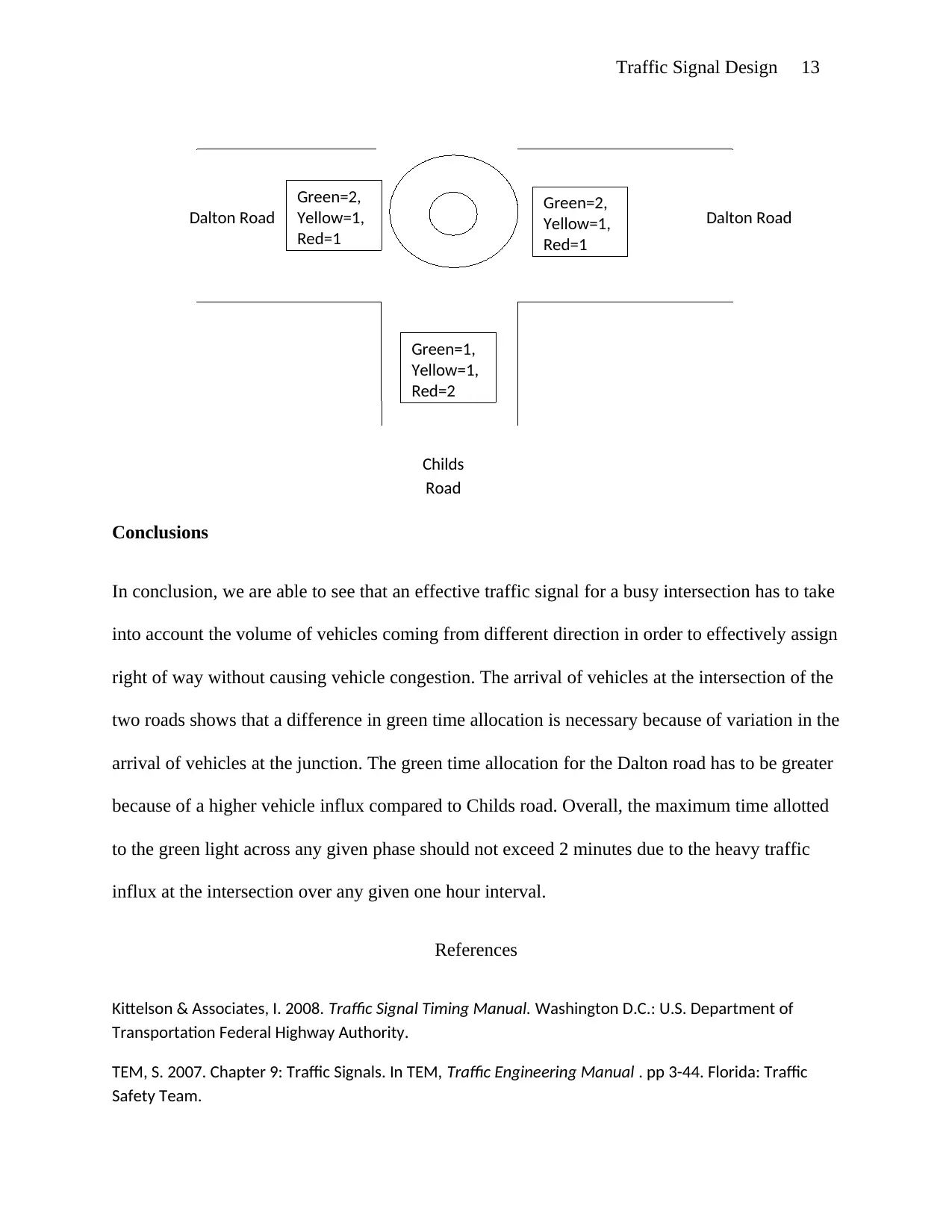
Traffic Signal Design 13
Conclusions
In conclusion, we are able to see that an effective traffic signal for a busy intersection has to take
into account the volume of vehicles coming from different direction in order to effectively assign
right of way without causing vehicle congestion. The arrival of vehicles at the intersection of the
two roads shows that a difference in green time allocation is necessary because of variation in the
arrival of vehicles at the junction. The green time allocation for the Dalton road has to be greater
because of a higher vehicle influx compared to Childs road. Overall, the maximum time allotted
to the green light across any given phase should not exceed 2 minutes due to the heavy traffic
influx at the intersection over any given one hour interval.
References
Kittelson & Associates, I. 2008. Traffic Signal Timing Manual. Washington D.C.: U.S. Department of
Transportation Federal Highway Authority.
TEM, S. 2007. Chapter 9: Traffic Signals. In TEM, Traffic Engineering Manual . pp 3-44. Florida: Traffic
Safety Team.
Dalton Road Dalton Road
Childs
Road
Green=2,
Yellow=1,
Red=1
Green=2,
Yellow=1,
Red=1
Green=1,
Yellow=1,
Red=2
Conclusions
In conclusion, we are able to see that an effective traffic signal for a busy intersection has to take
into account the volume of vehicles coming from different direction in order to effectively assign
right of way without causing vehicle congestion. The arrival of vehicles at the intersection of the
two roads shows that a difference in green time allocation is necessary because of variation in the
arrival of vehicles at the junction. The green time allocation for the Dalton road has to be greater
because of a higher vehicle influx compared to Childs road. Overall, the maximum time allotted
to the green light across any given phase should not exceed 2 minutes due to the heavy traffic
influx at the intersection over any given one hour interval.
References
Kittelson & Associates, I. 2008. Traffic Signal Timing Manual. Washington D.C.: U.S. Department of
Transportation Federal Highway Authority.
TEM, S. 2007. Chapter 9: Traffic Signals. In TEM, Traffic Engineering Manual . pp 3-44. Florida: Traffic
Safety Team.
Dalton Road Dalton Road
Childs
Road
Green=2,
Yellow=1,
Red=1
Green=2,
Yellow=1,
Red=1
Green=1,
Yellow=1,
Red=2
Paraphrase This Document
Need a fresh take? Get an instant paraphrase of this document with our AI Paraphraser

Traffic Signal Design 14
1 out of 14
Your All-in-One AI-Powered Toolkit for Academic Success.
+13062052269
info@desklib.com
Available 24*7 on WhatsApp / Email
![[object Object]](/_next/static/media/star-bottom.7253800d.svg)
Unlock your academic potential
© 2024 | Zucol Services PVT LTD | All rights reserved.